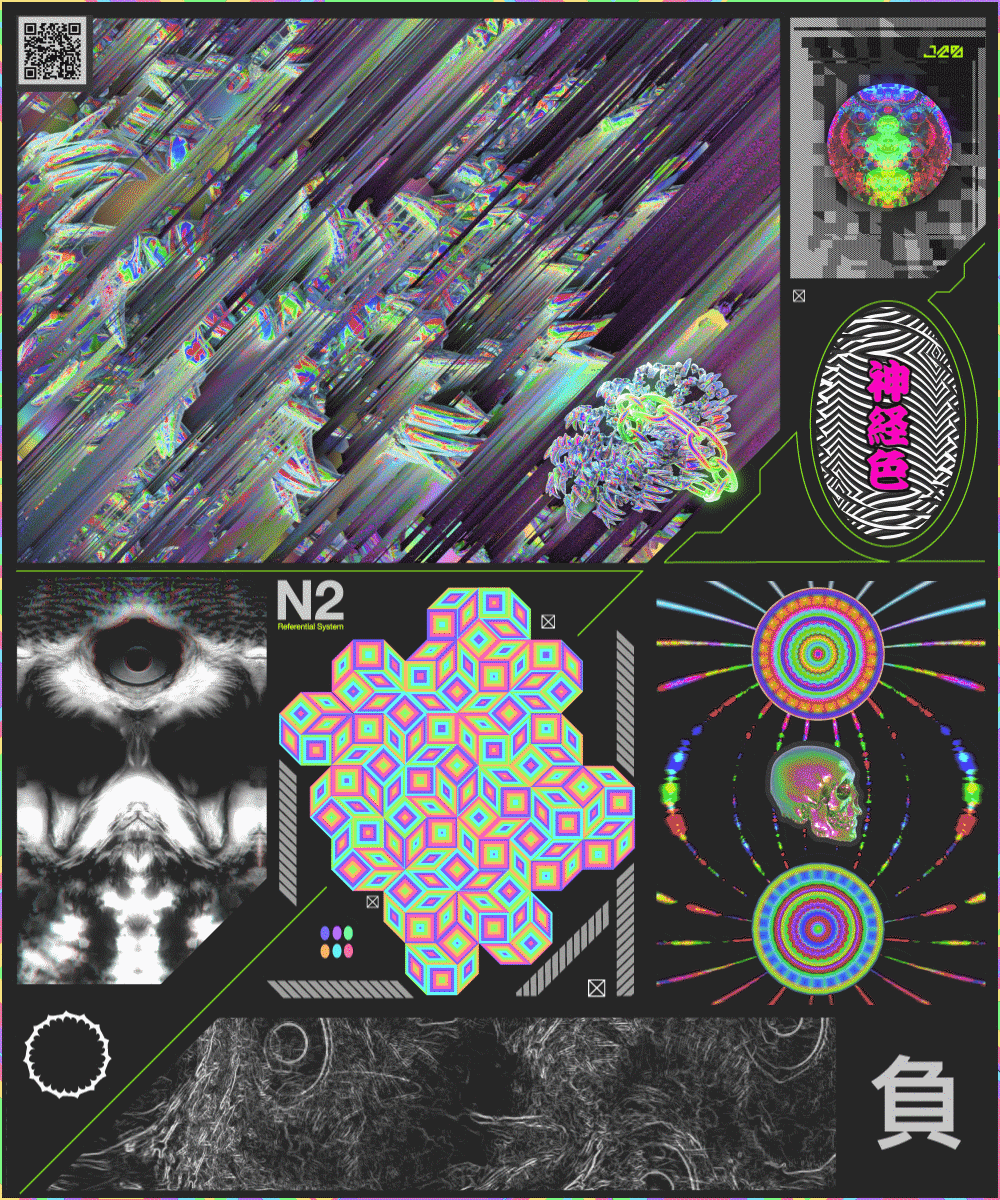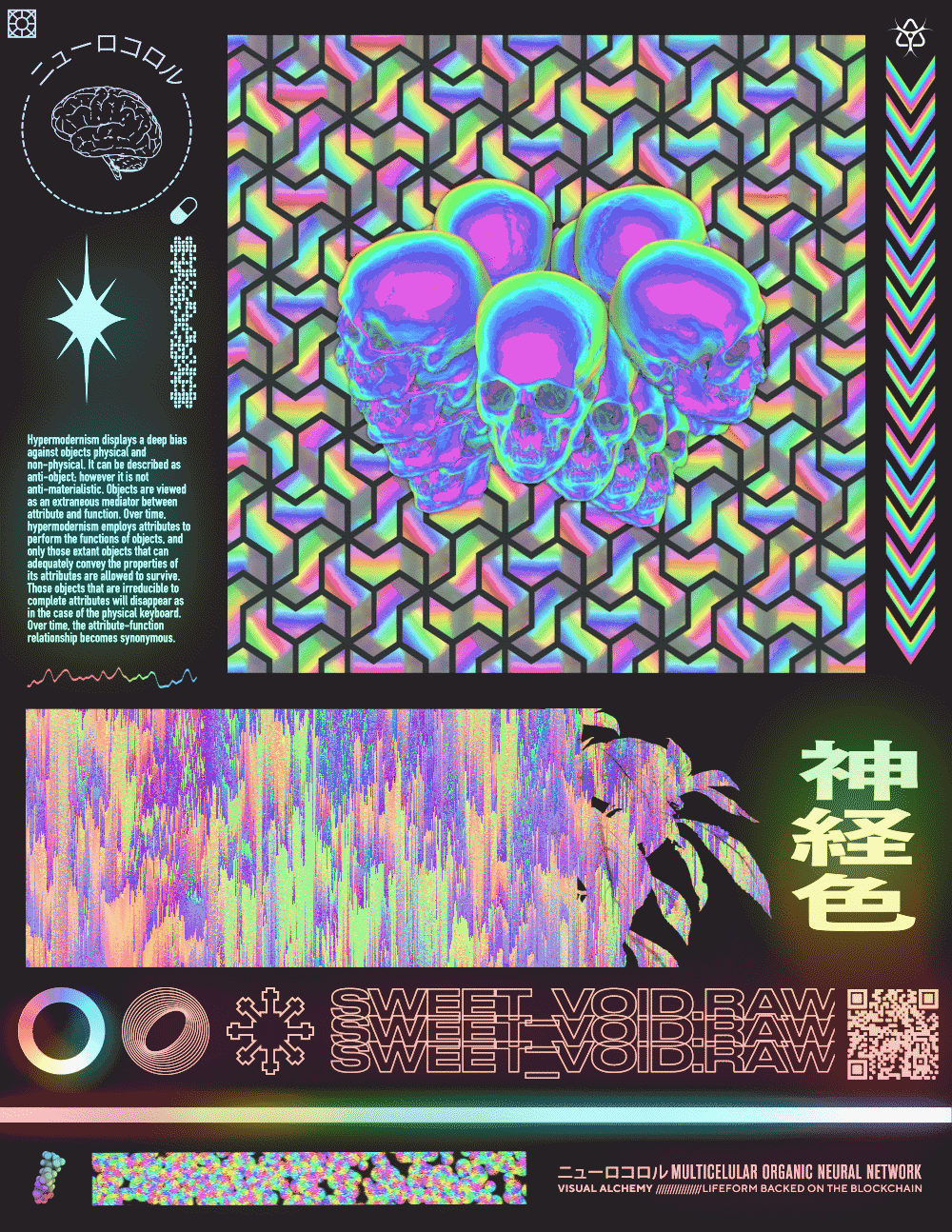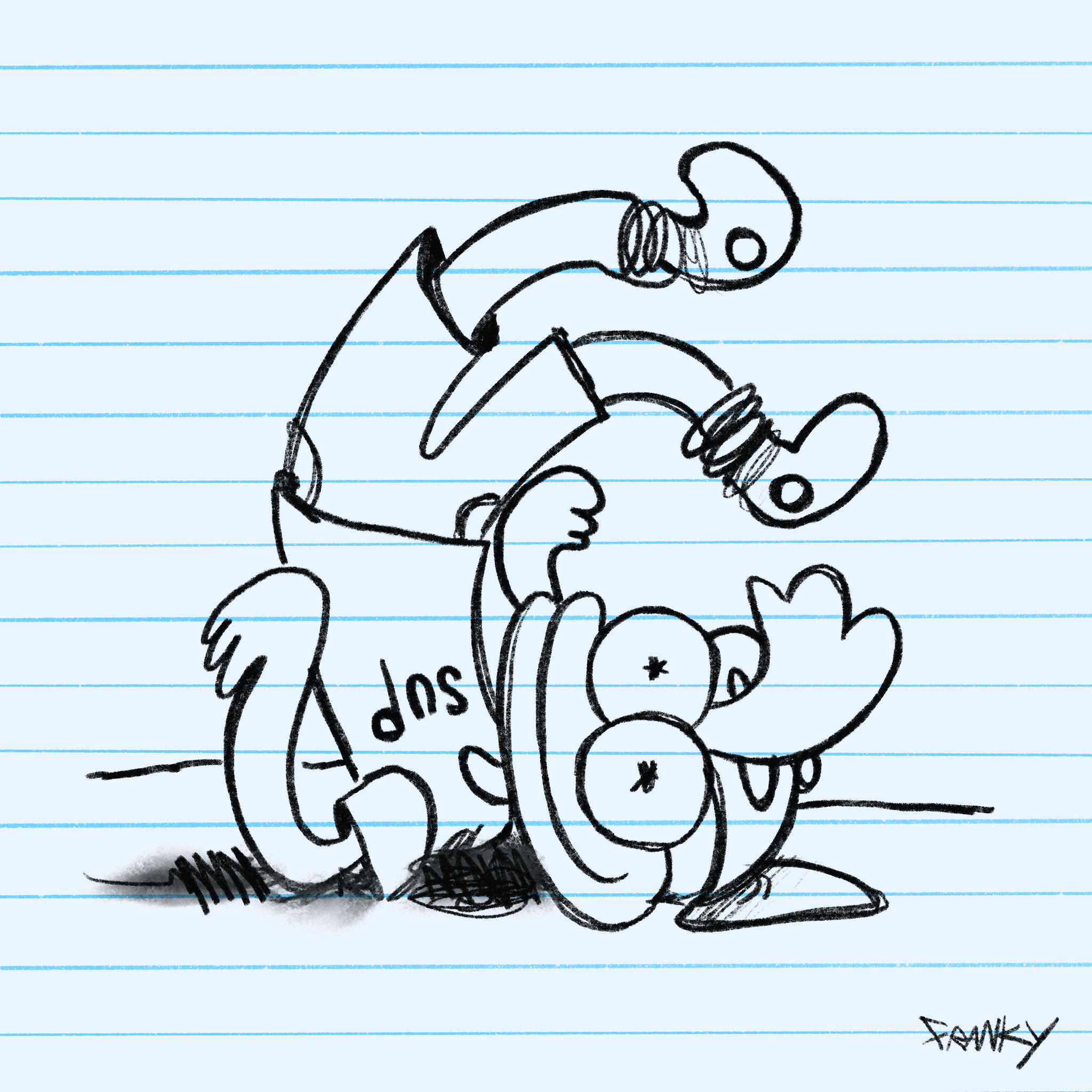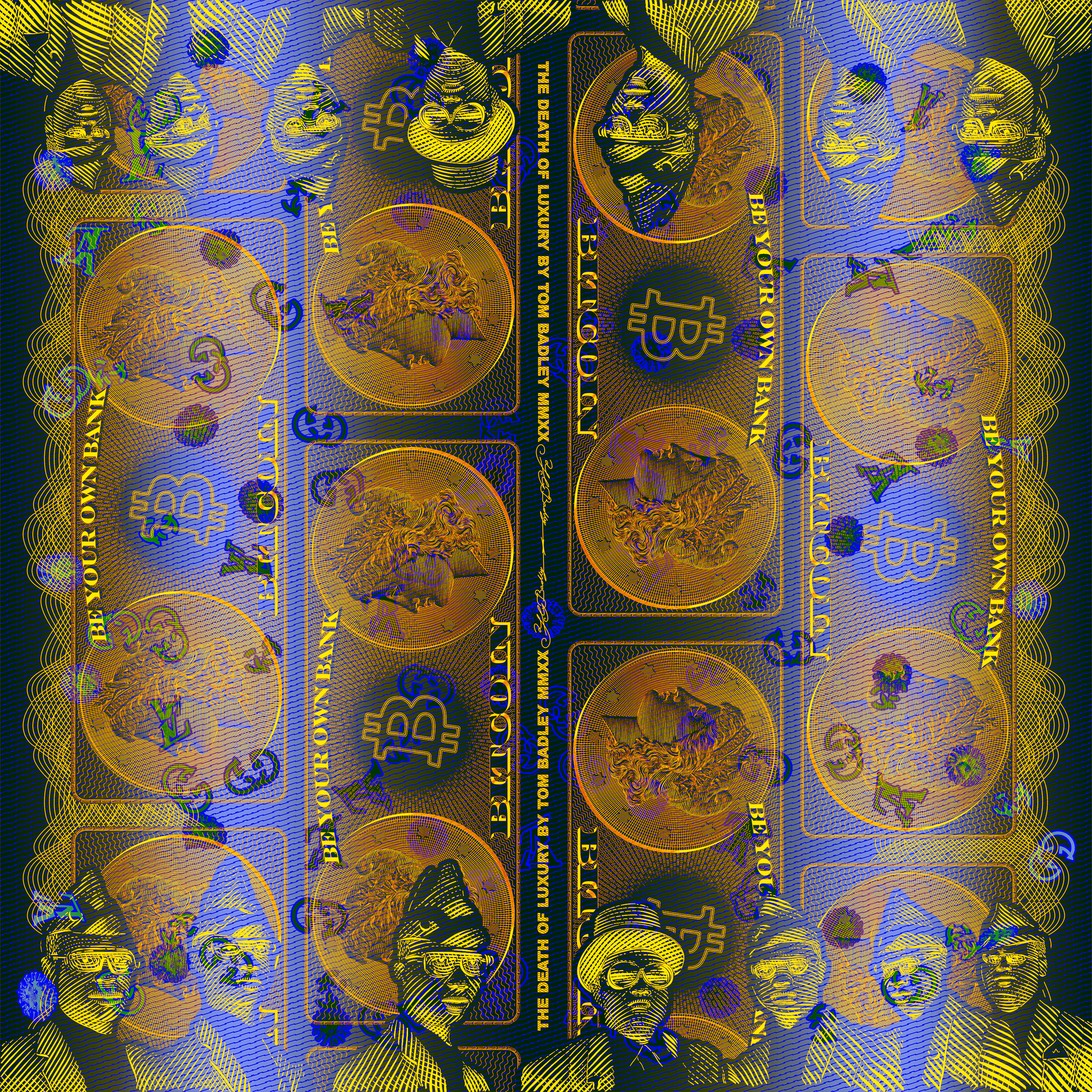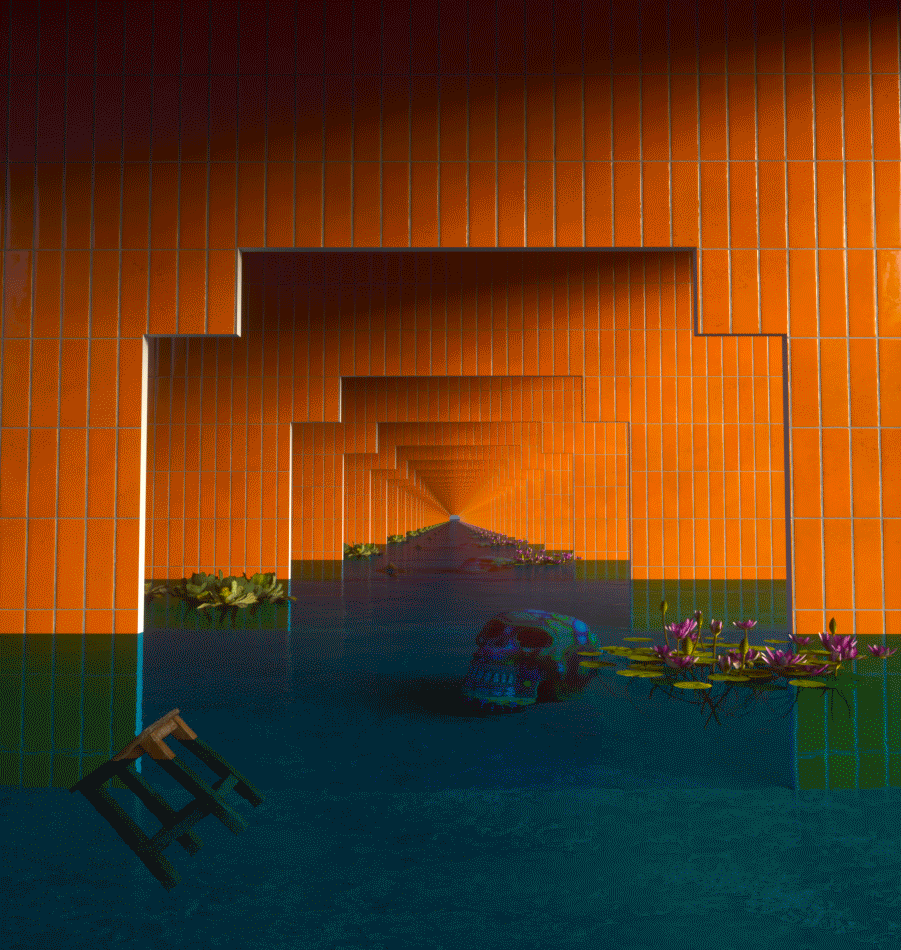SuperRare Labs Senior Curator An interviews ALIENQUEEN about psychedelics, death, and her journey in the NFT space.

Life in neurocolor: How the early aughts internet shaped the aesthetics of web3
Above: “Archeology of the Future” by @neurocolor
Life in neurocolor: How the early aughts internet shaped the aesthetics of web3
The first time I spoke to painter, street and digital artist neurocolor via email, he invited me to the “underground places” of Mexico City where we would drink mezcal and not tequila, because “tequila, you can drink it anywhere else in the world ;)” We made plans to go to readings and restaurants, to visit Coyoacan street art and the pyramids at Teotihuacan. On my first day there, after pulling together an outfit from the selection of clothes still packed in my bag from my previous work trip, I walked out the door of my one-room Airbnb and looked for a guy in a gray VW. I had no idea what neurocolor looked like, or what his real name was, but like a white girl on vacay in a foreign country, I saw what I thought was the right car and got in.
A young man with messy black hair and thick, blue-rimmed glasses sat behind the wheel. In the passenger seat was Ann Ahoy, a tattoo and crypto artist from Germany. The three of us were on our way to Bitcoin Embassy Bar, a place where crypto enthusiasts could sit, have a drink, pay in crypto, and attend events exploring everything from DeFi to NFTs.
When we arrived after a quick dinner at Pizza del Perro Negro, neuro was greeted by the entire room at once, it seemed, and disappeared into the crowd. I was sipping a frozen paloma sprinkled with chili and lime when I felt a tap on my shoulder. neuro motioned his thumb towards a stranger in a green bomber jacket wearing round glasses and a shy smile. “Criptocromo,” he said.

Photo by the author
After hearing a presentation about a multimedia literature project that would soon be minted as an NFT, we all gathered around to talk about everything from urban landscapes to politics in the art world to problems facing cryptocurrencies and environmentalism. As someone who ditched academia to work in crypto, I was delighted to find people who wanted to talk about blockchain in broader contexts. I mentioned that I was a vegetarian at dinner (because almost everything served in Mexico has meat in it, unless by request), so when I then brought up the supply chain issues that made so many items harder to find, neuro looked at me and said, “you are one of those coastal leftist vegans who thinks the world is overpopulated, aren’t you?”
“I’m definitely not vegan,” I laughed cautiously, worried that I had somehow come off too progressive at dinner.
The event featured some of the biggest names in cryptoart, and I couldn’t believe how eager they all were to get to know me. The community created by the intersection of Mexican hospitality and cryptoart was immediately evident, a community that lent even outsiders like me the kind of familiarity usually reserved for people who had spent years earning their place. neurocolor, in particular, had offered himself as something like a personal guide, informing me of the best places to go to eat and drink, introducing me to nearly all of the artists we had intended to meet, even telling me in that first car ride how Mexican politics affected art and culture in the nation’s capital and beyond. He was forward, opinionated, articulate in both Spanish and English, and his humor was so dry that it took me 3 days and someone else pointing it out to realize he was teasing me.
Classic chilango.
The next day, we were supposed to go to the pyramids, but due to COVID they were closed to the public, viewable only from afar. “Not worth the drive,” we agreed, even though I wanted so badly to go. In Monterrey, the northern Mexican town where my family lives, there are no monuments of the past. The Olmec and Toltec tribes that lived there were nomadic, roaming but never settling, simultaneously homeless yet at home on the road. So instead, I stayed in, working until night came, messaging neuro on Twitter to make alternate plans. Walking tour? Too touristy. Art museum? Too stuffy. Salsa? Not really my thing.
We landed on Sunday dinner, meeting after my walking tour through the mural and graffiti-adorned streets of Coyoacan, one of the oldest neighborhoods of Mexico City. Sitting at a Oaxacan restaurant, we ordered a large “pizza” made out of tortilla, beans, and cheese.


“Should we get chapulines?” he asked. “We should get chapulines.” I nodded, not totally sure what those were and unable to search the web because my cell service was so bad. The waiter came and neuro ordered in Spanish: a bottle of mezcal, guacamole, and the Mexican pizza con chapulines en el lado. After the waiter left, I asked him about his art, and how he came to crypto. “I probably learned how to draw before I was speaking fluently in my own language,” he said. Even his earliest drawings showed promise, and he quickly became obsessed with visual art. “I was starting with mostly self-taught Photoshop Illustrator, obviously pirated copies here in Mexico,” he said with a chuckle. “You don’t have to put that in the article.”
neurocolor studied visual art in college and immediately fell in love with painting. “But yeah, now I consider that my dark ages, because I really like to paint, but I was always more into digital. And in school, there was too much of an attitude, like, ‘digital art is not real art,’ or ‘graffiti is not that real art,’ ‘painting is the most important manifestation and expression of visual art.’”
But with digital art, there was an audience hungry for work outside of the classical. The 2000s were the breeding ground for what would eventually become the first global art movement in the history of the world. DEPTHCORE, Deviant Art, and Flickr were open spaces for artists, animators, photographers, and meme makers to drop their art and share them with online communities. “[On DEPTHCORE] it was kind of like abstract, futurist, 3D, vectors, explorations, where it was just so much fun to feel the wonder that was coming out of it.” These styles of digital art, informed by both the information age and the communities being formed on the internet, were emotional, dark, glitchy, strange, different from everything that had come before. A burgeoning group of digital artists were creating their own lexicons, symbols, and values, transforming themselves from angsty teens to internet culture connoisseurs who, at base, cared about free expression, and who would eventually become the NFT artists and collectors championing the cryptoart movement today.
It was a weird time, not only because millennials were the first generation to grow up with computers in our homes, but because we survived the 1990s and Y2K. The dialect of “The Matrix” and other sci-fi classics about computers and alternate realities were very much part of our collective consciousness. Were we Neo or Mr. Anderson, a human or a machine?
“Well in Mexico, we never really thought that society was going to crash [in 1999],” Neuro interjected, “because we have always been in the crash, we have always been crashed,” he said, furrowing his brow in a way that I quickly noticed was the natural state of his face. “We are already living in a dystopia.”
Up until the 1990s, pollution in Mexico City was so bad that if you weren’t used to the air quality, you would have trouble breathing. Cars ran on leaded fuel, and the industrial nature of the city combined with the natural layout (a basin located over 2,000 meters above sea level and surrounded by mountains, pounded down by intense solar radiation) concentrated the pollutants further. Then you had political corruption that was, up until recently, unparalleled by most other countries.
But perhaps it is that very relationship with dystopia that makes neuro’s artwork feel so vibrant yet dark, so anachronistic and yet immediate. With contrasting deep grays and iridescent colors, a distinctive spinning carousel-style animation, and a fascination with skulls and mythological creatures, each piece by neurocolor is both nostalgic and futuristic. But even then I had to ask, “why so many skulls? Is that a Mexican thing or are you just kind of emo?”
“Both!” He laughed. “I mean, people from Mesoamerica, they like skulls, and people nowadays like skulls. The thing is, skulls are badass.”
Not wrong.
Mexicans love that shit. We love the idea that spirits are friendly, that lost loved ones come back to visit us, that death is not the end, but a new beginning. When the Spanish first came across the ancient Aztec capital of Tenochtitlan, modern-day Mexico City, they were greeted by a tower of skulls. They were freaked out, naturally, by what they perceived as an aggressive display of the macabre, but to the Aztecs, these skulls were a celebration of life.
“I know it’s cryptic to remind you of things like that, but the aesthetics, the shapes of the skulls, are crazy,” he added. “I don’t know. It’s very heavy, like, I imagine scenes in the times before civilization, people were using skeletons as decorations, like skulls from other animals. It’s like we have been in touch with these symbols for so long. They are a part of our visual imaginations.”
Thinking about how intricate his artworks are, usually having multiple moving parts, several animated layers, along with references to video games, science fiction, and anime, and sometimes even integrating phrases from Japanese words, I had to ask: How did he come up with his concepts? When did he know when a piece was finished?
“Nothing in my process is logical,” he said. “I don’t follow plans; I don’t have plans for pieces. I just create assets, and then I start to play with them until I have something that clicks. It’s like I’m drifting,” he continued, making a wobbling motion with his hands, and narrowing his gaze. “It’s like an exploration with a compass, a very weak compass. I have to say, I like to let myself flow. It’s a new thing that I’m using a lot of grays, a lot of blacks, but for me it’s always making something that clicks internally.” A strategy not unlike mine, when a single line in my head blossoms into an entire poem. It reminded me that art, no matter the medium, often comes from intuition.
And as the mezcal gave way to louder voices and more talk of the grim, our main dish arrived. The pizza quesadilla was massive, filled with the rich, stringy cheese of Oaxaca and black beans. On the side was a ramekin filled with little brown…insects?!
“What the fuck is THAT?” I blurted.
“Chapulines,” neuro said matter of factly. “Grasshoppers. Try it! It’s delicious.”
I took my knife and twirled the bugs with its point, making them wriggle as if still alive. About half an hour and several mezcals later, I built up the courage to eat some. They were salty and a little crunchy, seasoned, like most everything in Mexico, with salt and lime. “When the earth is totally polluted and the bugs rule the world, we Mexicans will be just fine,” neuro said, plopping another few grasshoppers on his plate. “Hakuna matata.”

Photo by Nathan Beer
It was a few days and several meals before I would learn neurocolor’s birth name, but by then, it felt wrong to say it out loud, especially to him. I realized that it wasn’t his real name at all. Sitting on a sofa in Casa Patricio, the community house in the heart of Del Valle, a neighborhood affectionately nicknamed “Crypto Valley” by the numerous crypto artists who lived there, I asked neuro about his pseudonym and why he preferred to use it IRL.
“I was a teenager in the beginning of the 2000s. I was going to electronic music clubs. And so I grew up admiring DJs and graffiti artists and all of them had one name, and liked the name they created for themselves.” Kind of like the AIM usernames and Myspace extensions we chose to identify with on the internet. “I don’t like this idea that your real name is imposed by your parents. I mean, it’s an imposition, it’s an unnecessary imposition, because you need to be named somehow to function in society. So getting your own name, getting your own persona allows you to be born again,” and in some ways, to become your true self.
But perhaps the most revelatory aspect of both blockchain and the cryptoart network built on it is the freedom it allows artists like neuro, who were stuck teaching and altering their styles in order to fit in. “In Mexico, [crypto artists] are so few, and we are used to a really shitty reality in the art world,” he told me. Like so many aspects of life in Mexico, it is a restricted reality, with predetermined outcomes, and preselected winners and losers. “I always liked how [in the U.S.] you could be a painter and do new stuff, and you are still going to have a market. In Mexico, there was only a market for very cliche ideas. Like you have to be doing hyper-realism or neo-conceptual art that was so hot in the ‘90s, but not anymore, and you have to apply for a grant from the government, et cetera. So you have to either make the government happy or follow the really old fashioned art market here.”
Effectively, there was no room for innovation, and even less for people who wanted to break from tradition. “So for us getting to know about crypto, evolving with cryptoart and with crypto in general, allowed us to break that barrier and be connected with people all over the world. That was kind of possible with the web 2.0, but, nah, it was far from being this dynamic.”

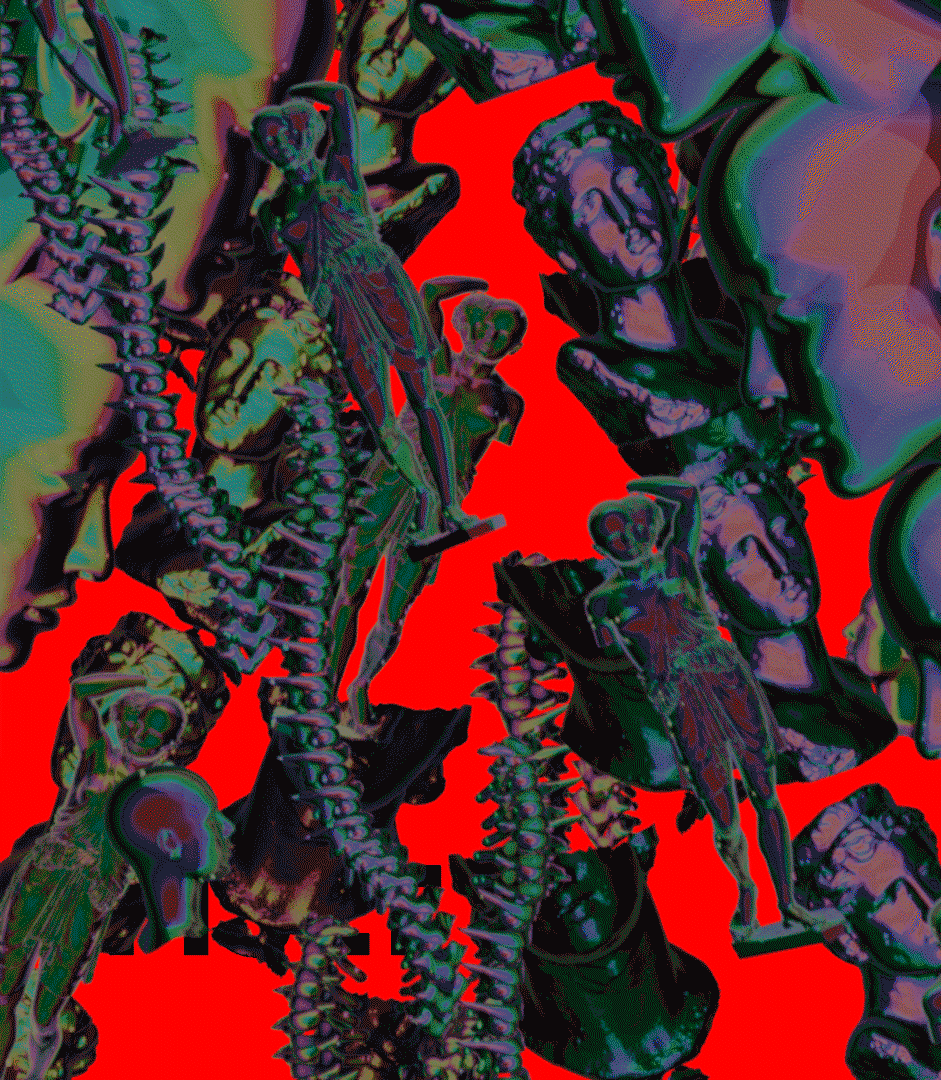
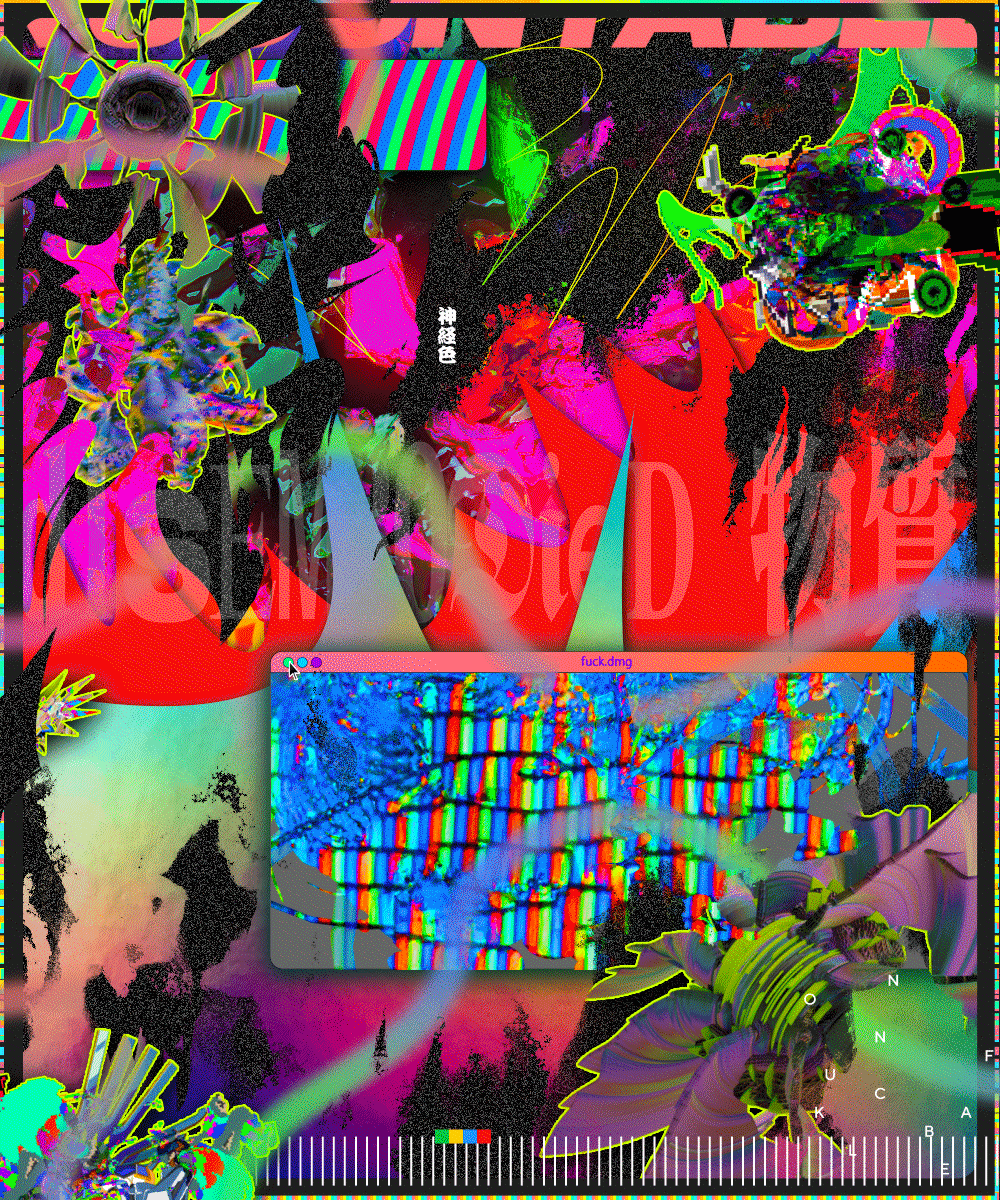

And as talk of crypto slowly turned into talk of capital, corruption, and social instability in Mexico, I wondered if there wasn’t something historical about what I was witnessing. I had been searching my whole life for this kind of environment, one where insanely smart people spoke about insanely cool stuff, conversation reaching deep into the night for a revelation that would inspire the next great novel, the next great mural, the next great generation of creators. Had Mexico City turned out to be the post-war Paris I wanted New York to be?
A few days later, we went to Xochilmilco, the place where long, Aztec-style boats covered in flowers and vibrant paint drifted along the swampy part of the city. Nearly everyone we came to visit made time to join.
neurocolor grew up in Unidad Independencia, a neighborhood filled with lush vegetation, balconies with pieces of laundry hanging outside of them, and windows ordained with plants and clay pottery. We drove by it on our way to Xochilmilco, his music blasting through the car’s speakers. I sat in the back with Moxarra and his dog, Galleta, bopping my head along and taking notes.

Photo by @oveck
The drive was a bit long, but it was certainly worth the prize at the end. A huge port was filled with boats of varying sizes and colors. We got on one and ordered our first round of drinks. Beer, micheladas, and seltzer were served in giant styrofoam cups rimmed in sugar, salt, and chile, some dyed in crazy colors, perhaps to match the boats. Our guide pushed us off shore, and steered the boat from the back with a long oar, kind of like the boats in Venice. neuro’s speaker blasted electronica and he danced along, clearly in his element. As I began talking to Criptocromo about dreams, a tiny boat paddled up next to us offering an array of snacks. Then a bit more downstream, another, selling something else.
Afterward, we went back to the SuperRare AirBnb for a last-minute soiree where we ordered pizza, pasta, and a salad that only Ann and I ate. It was heartwarming to see how much these artists wanted to hang out with each other, and with us, how willing they were to drop other plans to make space for the spontaneous.
“Wait, so you told me why you prefer to be anonymous, but you never told me how you picked your name,” I said to neuro sometime in the night. “It’s like the idea, when you watch cartoons from the ‘50’s, and they were colored by technicolor? That was like the mother and this is the contemporary version of that concept,” he said, pouring some mezcal into a mug. “Then add the psychedelic: What is a color in your mind? It’s what your brain perceives it to be. So basically, every color is a neurocolor.” When he said it, I thought about eyes, specifically, retinas. One part of the retina was responsible for perceiving changes in light, shape, and movement, and the other part was responsible for interpreting color. Interesting, then, that his artworks so often used only grays in some parts, and only color in others.
We walked over to the dining room table where the artists were passing around two pieces of paper with the words “Super” and “Rare” outlined in pencil, with crazy details drawn over it in pen. Each artist had added their mark, showing a beautiful, creepy, and expertly detailed text. neurocolor sat down to add his.
Watching him sweep the point of the pen across the paper, I stood amazed. Here was a guy, not much older than myself, who had broken into an art world still emerging. A guy who, like me, had been stuck teaching and resisting pressures to change his art while waiting–working–for his dreams to come true. To me, this was the power of crypto: to create space, and opportunities, for people like us.
The Sunday before we left, we decided to go to Lagunilla–another one of neuro’s suggestions–a large outdoor market where one could find delicious street food, priceless knickknacks, cool vintage clothing, antique furniture, and more. When we arrived, we found neuro, Ann Ahoy, and Criptocromo waiting for us.
“Why are you always so early?” I asked, joking.
“I’m neurotic,” neuro said, taking a handful of something out of a clear plastic bag and putting it in his mouth.
“What are you eating?”
“My own custom snack. Patatinas with chapulines and lime.”
After a few daytime drinks, a little bit of shopping, and a bunch of delicious food, we went back to Casa Patricio one last time. My early flight back to New York loomed over me. But somewhere in the market I had found a skull with marbled greens, reds, and blues. “Nice find,” neuro had told me. When I got back to my East Village apartment, I placed it on the shelf beside my bed, to remind me of a new place that feels like home, too.
Tech





Out of the Vault and onto the Chain: the Evolving Nature of Provenance
SuperRare editor Oli Scialdone considers the social experience of provenance and its relationship with community in the Web3 space.
Curators' Choice










Curated Conversations: ALIENQUEEN
SuperRare Labs Senior Curator An interviews ALIENQUEEN about psychedelics, death, and her journey in the NFT space.

